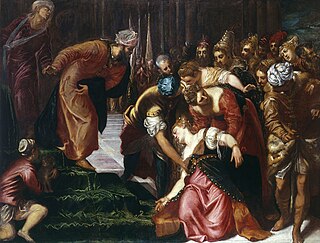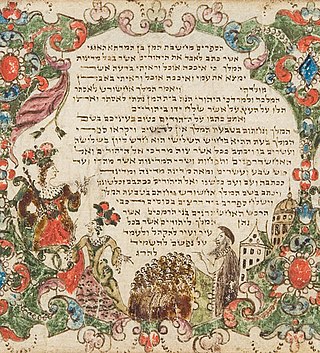Esther Before Ahasuerus may refer to:
Esther Before Ahasuerus may refer to:

The Book of Esther, also known in Hebrew as "the Scroll", is a book in the third section of the Jewish Tanakh. It is one of the five Scrolls in the Hebrew Bible and later became part of the Christian Old Testament.

Esther is the eponymous heroine of the Book of Esther. Set in the Persian Achaemenid Empire, it tells how king Ahasuerus seeks a new wife after his queen, Vashti, is deposed for disobeying him. Esther is chosen to fulfill this role due to her beauty. Ahasuerus' grand vizier, Haman, is offended by Esther's cousin and guardian, Mordecai, due to his refusal to prostrate himself before Haman. Consequently, Haman plots to have all the Jewish subjects of Persia killed, and convinces Ahasuerus to permit him to do so. However, Esther foils the plan by revealing Haman's eradication plans to Ahasuerus, who then has Haman executed and grants permission to the Jews to kill their enemies instead, as royal edicts cannot be revoked under Persian law.

Ahasuerus is a name applied in the Hebrew Bible to three rulers and to a Babylonian official in the Book of Tobit. It is a transliteration of either Xerxes or Artaxerxes; both are names of multiple Achaemenid dynasty Persian kings.

Purim is a Jewish holiday which commemorates the saving of the Jewish people of Persia from being annihilated according to an evil decree instituted by Haman, an official of the Achaemenid Empire as recounted in the Book of Esther.
Abagtha (אבגתא) was a court official of King Ahasuerus. He is mentioned once in the Book of Esther. According to this narrative, King Ahasuerus commanded Abagtha and six other officials to parade the Queen Vashti before the king and his ministers in the crown jewels. Her refusal led to her demise and the selection of Esther as the new queen of the Persian Empire.

Vashti was a queen of Persia and the first wife of Persian king Ahasuerus in the Book of Esther, a book included within the Tanakh and the Old Testament which is read on the Jewish holiday of Purim. She was either executed or banished for her refusal to appear at the king's banquet to show her beauty as Ahasuerus wished, and was succeeded as queen by Esther, a Jew. That refusal might be better understood via the Jewish tradition that she was ordered to appear naked. In the Midrash, Vashti is described as wicked and vain; she is viewed as an independent-minded heroine in feminist theological interpretations of the Purim story.

Haman is the main antagonist in the Book of Esther, who according to the Hebrew Bible was an official in the court of the Persian empire under King Ahasuerus, commonly identified as Xerxes I but traditionally equated with Artaxerxes I or Artaxerxes II. As his epithet Agagite indicates, Haman was a descendant of Agag, the king of the Amalekites. Some commentators interpret this descent to be symbolic, due to his similar personality.

Esther is an oratorio by George Frideric Handel. It is generally acknowledged to be the first English oratorio. Handel set a libretto after the Old Testament drama by Jean Racine. The work was originally composed in 1718, but was heavily revised into a full oratorio in 1732.

This article is about Esther in rabbinic literature. Esther was the chief character in the Book of Esther. She is counted among the prophetesses of Israel. Allusions in rabbinic literature to the Biblical story of Esther contain various expansions, elaborations and inferences beyond the text presented in the book of the Bible.
Esther is a play in three acts written in 1689 by the French dramatist, Jean Racine. It was premièred on January 26, 1689, performed by the pupils of the Maison royale de Saint-Louis, an educational institute for young girls of noble birth. The subject is taken from the biblical Book of Esther.

The painting Ahasveros and Haman at the Feast of Esther is one of the few works of Rembrandt van Rijn whose complete provenance is known. The origin of the painting can be traced back to 1662, two years after its completion.
There are only three figures in the picture and the banquet is suggested sketchily. Esther lowers her arms apprehensively as she finishes her speech, the king's lips are pursed in anger, and Haman's pose reveals a sense of doom. The distance between the king and his vizier seems enormous, while the king and queen form a united pair.
Zeresh was the wife of Haman the Agagite who is mentioned in the Hebrew Bible in the Book of Esther.

Esther and the King is a 1960 American-Italian religious epic film produced and directed by Raoul Walsh and starring Joan Collins as Esther, Richard Egan as Ahasuerus, and Denis O'Dea as Mordecai. Walsh and Michael Elkins wrote the screenplay, which was based on the Book of Esther of the Hebrew Bible and the Old Testament. It recounts the origin of the Jewish celebration of Purim.

Esther, also known as The Bible: Esther, is a 1999 American-Italian-German television film based on the Book of Esther, directed by Raffaele Mertes and starring Louise Lombard as Queen Esther, F. Murray Abraham as Mordechai, Jürgen Prochnow as Haman, Thomas Kretschmann as King Achashverosh and Ornella Muti as Vashti.

The Toilette of Esther or Esther Preparing to be Presented to King Ahasuerus, is an 1841 oil-on-canvas painting by Théodore Chassériau. The painting depicts a moment from the scriptural Book of Esther, when Esther prepared to meet King Ahasuerus, ruler of Persia, who subsequently took her as his wife. The painting is in the Musée du Louvre. Vincent Pomarède of the Museum of Fine Arts of Lyon has described it as "one of the most famous (paintings) in the Louvre".

Esther Before Ahasuerus is a large painting of 1546–47 by the Venetian painter Tintoretto showing a scene from the Greek addition to the Book of Esther, in which Queen Esther faints during a bold intervention with her husband King Ahasuerus of Persia. In oil on canvas, it measures 207.7 by 275.5 centimetres. Since the 1620s it has been in the Royal Collection of the United Kingdom, and in 2019 it hung in the King's Gallery in Kensington Palace, London.

Esther Before Ahasuerus is a painting by the 17th-century Italian artist Artemisia Gentileschi. It shows the biblical heroine Esther going before Ahasuerus to beg him to spare her people. The painting is now in the Metropolitan Museum of Art in New York, having been donated to the museum by Elinor Dorrance Ingersoll in 1969. It is one of Gentileschi's lesser known works, but her use of lighting, characterization, and style help in successfully portraying Esther as a biblical heroine as well as the main protagonist of the work.

Life of Esther or Scenes from the Story of Esther is the title of a series of six panel paintings by Sandro Botticelli and Filippino Lippi, showing scenes from the story of Esther and produced in the 1470s. They originally decorated the sides of a pair of cassoni or marriage chests, the two long panels on the fronts, and the smaller ones on the ends. They are now split between five museums in Europe and Canada.

Esther 1 is the first chapter of the Book of Esther in the Hebrew Bible or the Old Testament of the Christian Bible. The author of the book is unknown and modern scholars have established that the final stage of the Hebrew text would have been formed by the second century BCE. Chapters 1 and 2 form the exposition of the book. This chapter records the royal banquets of the Persian king Ahasuerus until the deposal of queen Vashti.

Esther 3 is the third chapter of the Book of Esther in the Hebrew Bible or the Old Testament of the Christian Bible. The author of the book is unknown and modern scholars have established that the final stage of the Hebrew text would have been formed by the second century BCE. Chapters 3 to 8 contain the nine scenes that form the complication in the book. This chapter introduces Haman the Agagite, who is linked by his genealogy to King Agag, the enemy of Israel's King Saul, from whose father, Kish, Mordecai was descended. The king Ahasuerus elevated Haman to a high position in the court, and ordered everyone to bow down to him, but Mordecai refuses to do so to Haman, which is connected to Mordecai's Jewish identity (as Jews would only bow down to worship their own God ; this indirectly introduced the religious dimension of the story. Haman reacted by a vast plan to destroy not simply Mordecai, but his entire people, getting the approval from the king to arrange for a particular date of genocide, selected by casting a lot, or pur to fall on the thirteenth day of the twelfth month, Adar. The chapter ends with the confused reaction of the whole city of Susa due to the decree.